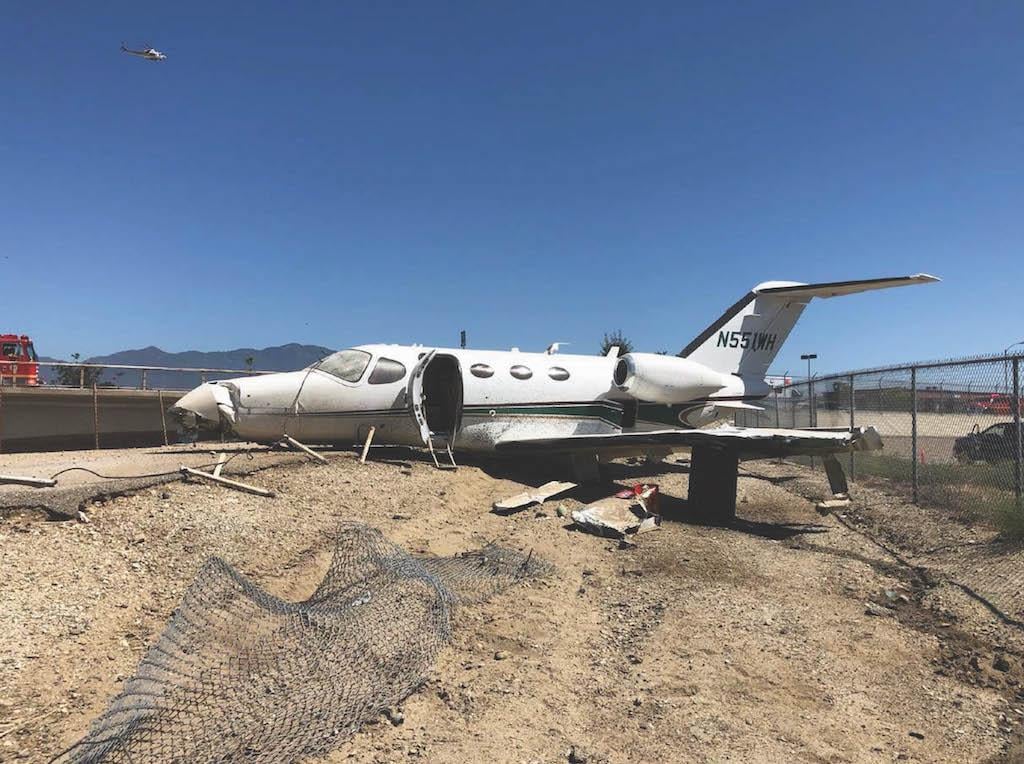
A Cessna Mustang ends up off the runway after attempting takeoff with the parking brake set.
This year’s NBAA-BACE Single-Pilot Safety Standdown includes a workshop exploring runway excursions that will go beyond an emphasis on stabilized approaches and promises to explore other factors that result in perfectly good aircraft running off the runway surface. While these mishaps plague aircraft of all sizes, I think smaller, single-pilot aircraft are more likely candidates for ending off the paved surface.
Can we explain a greater number of runway excursions with single pilots merely because they have the handicap of having one less pilot providing a set of eyes, making sure everything is done by the book? Certainly, but that does not mean single pilots cannot adopt some of the procedures that keep multipiloted aircraft on the runway more of the time.
Take, for example, the simple task of releasing an aircraft’s parking brake prior to takeoff. Many larger business jets post Crew Alerting System (CAS) messages and other warnings if the throttles are advanced with the brakes set. It seems paradoxical that the more expensive aircraft with larger crews have more of these “bells and whistles” while the smaller aircraft that could certainly benefit from these systems must do without. In 2019, a Cessna 510 Mustang ended up off the runway at El Monte-San Gabriel Valley Airport (KEMT), California, after the pilot lost control while aborting a takeoff with the parking brake set. The pilot had set the brake waiting for takeoff clearance, thought he had released it but did not visually confirm the fact. The aircraft was not equipped with a warning system to prevent this from happening. The pilot noticed the poor acceleration and aborted the takeoff, ending up off the runway’s pavement. We can learn from this incident and apply “big airplane” solutions that don’t require “big airplane” technology.
Use Three Senses: Hearing, Seeing, Touching
Having spent many hours in cockpit jump seats giving check rides, augmenting crews, or simply looking for a ride from Point A to Point B, I have noticed a particular technique of professional crews that deals with unexpected changes better than others. I have heard this technique called “Three-sense crew coordination” because it involves the hearing, seeing and touching senses.
You may have noticed that the simple act of extending the landing gear is not so simple, given that so many crews forget to do it. The sloppiest technique I have seen is where the captain extends his fist, thumb extended and pointed up, then rotates his wrist so his (or her) thumb is pointed down. No words are exchanged, it just happens. I thought that crew was a prime candidate for a gear up landing. The best technique is for the captain to say, “Gear down,” (hearing) and the first officer to lower the landing gear handle and keep his or her hand on the handle until the lights indicate the gear is down (seeing and touching). You can do this as a single pilot, too. Yes, this means you should talk to yourself. Say, “Gear down,” move the handle, keep your hand on the handle until you see the green lights, and repeat, “Gear is down.”
In our Citation Mustang parking brake example, say “Parking brake off,” with your hand on the handle; visually confirm the handle is fully seated, and finish by saying, “Parking brake is off.”
Be Predictable: Standard Operating Procedures (SOP) that are simple and always used
One of many ways to end up off a runway is to attempt to take off from the wrong runway. Professional aircrews long ago adopted the technique of verbalizing the takeoff clearance, looking for the correct runway numbers, and verifying that the takeoff heading aligns with the expected runway. “Cleared to take off Runway 28, I see the 28 runway numbers, our heading is 283.” We do this for every takeoff, even from our home airport and even from airports with only one runway. Every time. The best SOPs are the ones that are standard, and that are always used.
Solve problems before they turn into accidents: Embrace a Safety Management System (SMS)
I have heard from pilots at previous Single-Pilot Safety Standdowns that using a Safety Management System is overkill for their small one-pilot, one-airplane operation. I think such an operation may be in the most need of a good SMS, but the SMS does not have to be overly complicated and need not cost a dime. All you need is a written SOP, which could be as simple as your aircraft checklist, and a businesslike attitude that seeks to identify risks and come up with solutions. This, of course, is just a start along your SMS journey. But even in its earliest stages, an SMS program can yield great results.
Think of your last “close call,” where you managed to save the day but realized things could have gotten much worse. Let’s take for example our hapless Citation Mustang pilot who thought he had released his parking brake but had not. If you are flying a similar aircraft, you are at risk of also destroying your perfectly good airplane. The SMS method leads you to examine the circumstances and devise a way to mitigate the risk. It could be as simple as keeping your hand on the parking brake handle if set or never setting it at all while on the runway.
No matter what your solution, it is better to think about the solutions before they are needed!
